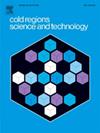雪晶的力学特性与本体关系分析:进展与展望
IF 3.8
2区 工程技术
Q1 ENGINEERING, CIVIL
引用次数: 0
摘要
雪是一种非均质材料,在宏观和微观层面上都具有复杂的特性。它的多孔结构和多晶态使其具有神秘莫测的微观结构。虽然对雪力学进行了大量的研究,但大多强调宏观变形行为,往往忽略了雪的微观结构对其宏观性能的影响。本文综述了雪晶的力学特性,并对几种流行的数值分析模型进行了研究。讨论了雪晶形态的历史发展,总结了雪的物理力学性能,如密度、颗粒级配、液态水含量(LWC)、弹性模量以及在压缩和剪切作用下的变形行为。本文还总结了积雪本体关系的常用分析模型,这些模型对于量化雪晶的微观参数并将其整合到宏观数值模拟中至关重要。最后,本文旨在加深对雪晶微观结构与宏观行为之间相互作用的理解,为雪的精细化本体建模提供理论支持。本文章由计算机程序翻译,如有差异,请以英文原文为准。
Analysis of mechanical properties and ontological relationships of snow crystals: Progress and prospects
Snow is a heterogeneous material with intricate properties at both macroscopic and microscopic levels. Its porous structure and polymorphism contribute to its enigmatic and unpredictable microstructure. Although extensive research has been conducted on snow mechanics, much of it emphasizes macroscopic deformation behavior, often overlooking the influence of snow's microstructure on its macroscopic properties. This review concentrates on the mechanical properties of snow crystals and examines several prevalent numerical analysis models. It discusses the historical development of snow crystal morphology and summarizes the physical and mechanical properties of snow, such as density, particle gradation, liquid water content (LWC), modulus of elasticity, and deformation behavior under compression and shear. The review also encapsulates the most commonly referenced analytical models for snow ontological relationships, which are crucial for quantifying the microscale parameters of snow crystals and integrating them into macroscopic numerical simulations. Ultimately, this review seeks to deepen the understanding of the interplay between the microstructure and macroscopic behavior of snow crystals, providing theoretical support for refined ontological modeling of snow.
求助全文
通过发布文献求助,成功后即可免费获取论文全文。
去求助
来源期刊

Cold Regions Science and Technology
工程技术-地球科学综合
CiteScore
7.40
自引率
12.20%
发文量
209
审稿时长
4.9 months
期刊介绍:
Cold Regions Science and Technology is an international journal dealing with the science and technical problems of cold environments in both the polar regions and more temperate locations. It includes fundamental aspects of cryospheric sciences which have applications for cold regions problems as well as engineering topics which relate to the cryosphere.
Emphasis is given to applied science with broad coverage of the physical and mechanical aspects of ice (including glaciers and sea ice), snow and snow avalanches, ice-water systems, ice-bonded soils and permafrost.
Relevant aspects of Earth science, materials science, offshore and river ice engineering are also of primary interest. These include icing of ships and structures as well as trafficability in cold environments. Technological advances for cold regions in research, development, and engineering practice are relevant to the journal. Theoretical papers must include a detailed discussion of the potential application of the theory to address cold regions problems. The journal serves a wide range of specialists, providing a medium for interdisciplinary communication and a convenient source of reference.
 求助内容:
求助内容: 应助结果提醒方式:
应助结果提醒方式:


